15.1 The Sociological Approach to Religion
From the Latin religio (respect for what is sacred) and religare (to bind, in the sense of an obligation), the term religion describes various systems of belief and practice concerning what people determine to be sacred or spiritual (Durkheim, 1915/1964; Fasching and deChant, 2001). Throughout history, and in societies across the world, leaders have used religious narratives, symbols, and traditions in an attempt to give more meaning to life and understand the universe. Some form of religion is found in every known culture, and it is usually practiced in a public way by a group. Religious practice can include feasts and festivals, God or gods, marriage and funeral services, music and art, meditation or initiation, sacrifice or service, and other aspects of culture.
Defining Religion
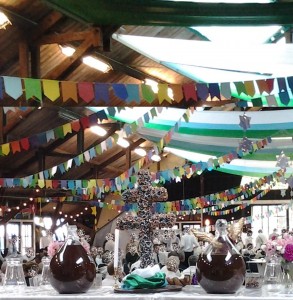
There are three different ways of defining religion in sociology — substantial definitions, functional definitions, and family resemblance definitions — each of which has consequences for what counts as a religion, and each of which has limitations and strengths in its explanatory power (Dawson and Thiessen, 2014). The problem of defining religion is not without real consequences, not least for questions of whether specific groups can obtain legal recognition as religions. In Canada there are clear benefits to being officially defined as a religion in terms of taxes, liberties, and protections from persecution. Guarantees of religious freedom under the Charter of Rights and Freedoms stem from whether practices or groups are regarded as legitimately religious or not. What definitions of religion do we use to decide these questions?
For example, the Céu do Montréal was established in 2000 as a chapter of the Brasilian Santo Daime church (Tupper, 2011). One of the sacraments specified in church doctrine and used in ceremonial rituals is ayahuasca, a psychedelic or entheogenic “tea” that induces visions when ingested. It must be imported from the Amazon rainforest where its ingredients are found. But because it contains N, N-dimethyltryptamine (DMT) and harmala alkaloids, it is a controlled substance under Canadian law. Importing and distributing this substance is considered trafficking and subject to criminal charges. Nevertheless, because of ayahuasca’s role as a sacrament in the church’s religious practice, Céu do Montréal was able to apply to the Office of Controlled Substances of Health Canada for a legal, Section 56 exemption to permit its lawful ceremonial use. Other neo-Vegetalismo groups who use ayahuasca in traditional Amazonian healing ceremonies in Canada, but do not have affiliations with a formal church-like organization, are not recognized as official religions, and therefore their use of ayahuasca remains criminalized and underground.
The problem of any definition of religion is to provide a statement that is at once narrow enough in scope to distinguish religion from other types of social activity, while considering the wide variety of practices that are recognizably religious in any common sense notion of the term. Substantial definitions attempt to outline the crucial characteristics that define what a religion is and is not. For example, Sir Edward Tylor argued that “a minimum definition of Religion [is] the belief in spiritual beings” (Tylor, 1871, cited in Stark, 1999), or as Sir James Frazer elaborated, “religion consists of two elements… a belief in powers higher than man and an attempt to propitiate or appease them” (Frazer, 1922, cited in Stark, ibid.). These definitions are strong in that they identify the key characteristic — belief in the supernatural — that distinguishes religion from other types of potentially similar social practice like politics or art. They are also easily and simply applied across societies, no matter how exotic or different the societies are. However, the problem with substantial definitions is that they tend to be too narrow. In the case of Tylor’s and Frazer’s definitions, emphasis on belief in the supernatural excludes some forms of religion like Theravadan Buddhism, Confucianism, or neo-paganism that do not recognize higher, spiritual beings, while also suggesting that religions are primarily about systems of beliefs, (i.e., a cognitive dimension of religion that ignores the emotive, ritual, or habitual dimensions that are often more significant for understanding actual religious practice).
On the other hand, functional definitions define religion by what it does or how it functions in society. For example, Milton Yinger’s definition is: “Religion is a system of beliefs and practices by means of which a group struggles with the ultimate problems of human life” (Yinger, 1970, cited in Dawson and Thiessen, 2014). A more elaborate functional definition is that of Mark Taylor (2007): religion is “an emergent, complex, adaptive network of symbols, myths, and rituals that, on the one hand, figure schemata of feeling, thinking, and acting in ways that lend life meaning and purpose and, on the other, disrupt, dislocate, and disfigure every stabilizing structure.” These definitions are strong in that they can capture the many forms that these religious problematics or dynamics can take — encompassing both Christianity and Theravadan Buddhism for example — but they also tend to be too inclusive, making it difficult to distinguish religion from non-religion. Is religion, for example, the only means by which social groups struggle with the ultimate problems of human life?
The third type of definition is the family resemblance model, in which religion is defined on the basis of a series of commonly shared attributes (Dawson and Thiessen, 2014). The family resemblance definition is based on the philosopher Ludwig Wittgenstein’s ordinary language definition of games (Wittgenstein, 1958). Games, like religions, resemble one another — we recognize them as belonging to a common category — and yet it is difficult to decide precisely and logically what the rule is that subsumes tiddly winks, solitaire, Dungeons and Dragons, and ice hockey under the category “games.” Therefore, the family resemblance model defines a complex “thing” like religion by listing a cluster of related attributes that are distinctive and shared by different versions of that thing, while noting that not every version of the thing will have all the attributes. The idea is that a family — even a real family — will hold a number of physiological traits in common, for example, which can be used to distinguish them from other families, even though each family member is unique, and any family member might not have all of them. You can still tell that the member belongs to one family over another because of the traits they share.
It is also possible to define religion in terms of a cluster of attributes based on family resemblance. This cluster includes four attributes: types of belief, ritual, experience, and social form. This type of definition has the ability to capture aspects of both the substantive and functional definitions. It can be based on common sense notions of what religion is and is not, without the drawback of being overly exclusive. While the thing, “religion,” itself becomes somewhat hazy in this definition, it does permit the sociologist to examine and compare religion based on these four dimensions while remaining confident that they are dealing with the same phenomenon.
The Four Dimensions of Religion
The incredible amount of variation between different religions makes it challenging to decide upon a concrete definition of religion that applies to all of them. To facilitate the sociological study of religion it is helpful to turn our attention to four dimensions that seem to be present, in varying forms and intensities, in all types of religion: belief, ritual, spiritual experience, and unique social forms of community (Dawson & Thiessen, 2014).
The first dimension is one that comes to mind for most Canadians when they think of religion, some systematic form of beliefs. Religious beliefs are a generalized system of ideas and values that shape how members of a religious group come to understand the world around them (see Table 15.1 and 15.2 below). They define the cognitive aspect of religion. These beliefs are taught to followers by religious authorities, such as priests, imams, or shamans, through formal creeds and doctrines, as well as more informal lessons learned through stories, songs, and myths. A creed outlines the basic principles and beliefs of a religion, such as the Nicene creed in Christianity (“I believe in the father, the son and the holy ghost…”), which is used in ceremonies as a formal statement of belief (Knowles, 2005).
| Religious Classification | What/Who Is Divine | Example |
|---|---|---|
| Polytheism | Multiple gods | Hinduism, Ancient Greeks, and Romans |
| Monotheism | Single god | Judaism, Islam, Christianity |
| Atheism | No deities | Atheism, Buddhism, Taoism |
| Animism | Nonhuman beings (animals, plants, natural world) | Indigenous nature worship, Shinto |
Belief systems provide people with certain ways of thinking and knowing that help them cope with ultimate questions that cannot be explained in any other way. One example is Weber’s (1915) concept of theodicy — an explanation of why, if a higher power does exist, good and innocent people experience misfortune and suffering. Weber argues that the problem of theodicy explains the prevalence of religion in our society. In the absence of other plausible explanations of the contradictory nature of existence, religious theodicies construct the world as meaningful. He gives several examples of theodicies — including karma, where the present actions and thoughts of a person have a direct influence on their future lives, and predestination, the idea that all events are an outcome God’s predetermined will.
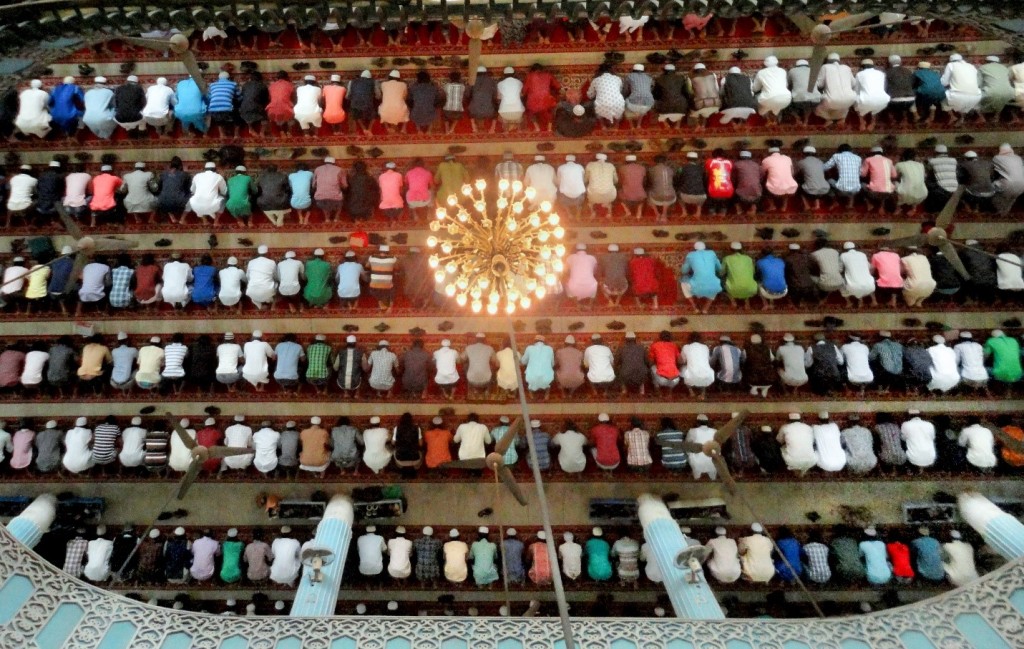
The second dimension, ritual, functions to anchor religious beliefs. Rituals are repeated physical gestures or activities, such as prayers and mantras, used to reinforce religious teachings, elicit spiritual feelings, and connect worshippers with a higher power. They reinforce the division between the sacred and the profane by defining the set of intricate processes and attitudes with which the sacred dimension of life can be approached.
A common type of ritual is a rite of passage, which marks a person’s transition from one stage of life to another. Examples of rites of passage common in contemporary Canadian culture include baptisms, Bar Mitzvahs, and weddings. They sacralize the process of identity transformation. When these rites are religious in nature, they often also mark the spiritual dangers of transformation. The Sun Dance rituals of many Native American tribes are rites of renewal which can also act as initiation-into-manhood rites for young men. They confer great prestige onto the pledgers who go through the ordeal, but there is also the possibility of failure. The sun dances last for several days, during which young men fast and dance around a pole to which they are connected by rawhide strips passed through the skin of the chest (Hoebel, 1978). During their weakened state, the pledgers are neither the person they were, nor yet the person they are becoming. Friends and family members gather in the camp to offer prayers of support and protection during this period of vulnerable “liminality.” Overall, rituals like this function to bring a group of people (although not necessarily just religious groups) together to create a common, elevated experience that increases social cohesion and solidarity.
From a psychological perspective, rituals play an important role in providing practitioners with access to spiritual “powers” of various sorts. In particular, they can access powers that both relieve or induce anxieties within a group depending on the circumstances. In relieving anxieties, religious rituals are often present at times when people face uncertainty or chance. In this sense they provide a basis of psychological stability. A famous example of this is Malinowski’s study of the Trobriand Islanders of New Guinea (1948). When fishing in the sheltered coves of the islands very little ritual was involved. It was not until fishermen decided to venture into the much more dangerous open ocean in search of bigger and riskier catches that a rigorous set of religious rituals were invoked, which worked to subdue the fears of not only the fisherman but the rest of the villagers.
In contrast, rituals can also be used to create anxieties that keep people in line with established norms. In the case of taboos, the designation of certain objects or acts as prohibited or sacred creates an aura of fear or anxiety around them. The observance of rituals is used to either prevent the transgression of taboos or to return society to normal after taboos have been transgressed. For example, early hunting societies observed a variety of rituals in their hunting practices to return the soul of the animal to its supernatural “owner.” Failure to observe these rituals was a transgression that threatened to unbalance the cosmological order and impact the success of future hunts. This failure could only be resolved through further specific rituals (Smith, 1982). In this example, sociologists would note that the taboo acts as a form of ritualized social control that encourages people to act in ways that benefit the wider society, such as the prevention of overhunting.
A third common dimension of various religions is the promise of access to some form of unique spiritual experience or feeling of immediate connection with a higher power. The pursuit of these indescribable experiences explains one set of motives behind the continued prevalence of religion in Canada and around the world. From this point of view, religion is not so much about thinking a certain way (i.e., a formal belief system) as about feeling a certain way. These experiences can come in several forms: the incredible visions or revelations of the religious founders or prophets (e.g., the experiences of the Buddha, Jesus, or Muhammed), the act of communicating with spirits through the altered states of consciousness used by tribal shamans, or the unique experiences of expanded consciousness accessed by individuals through prayer or meditation.
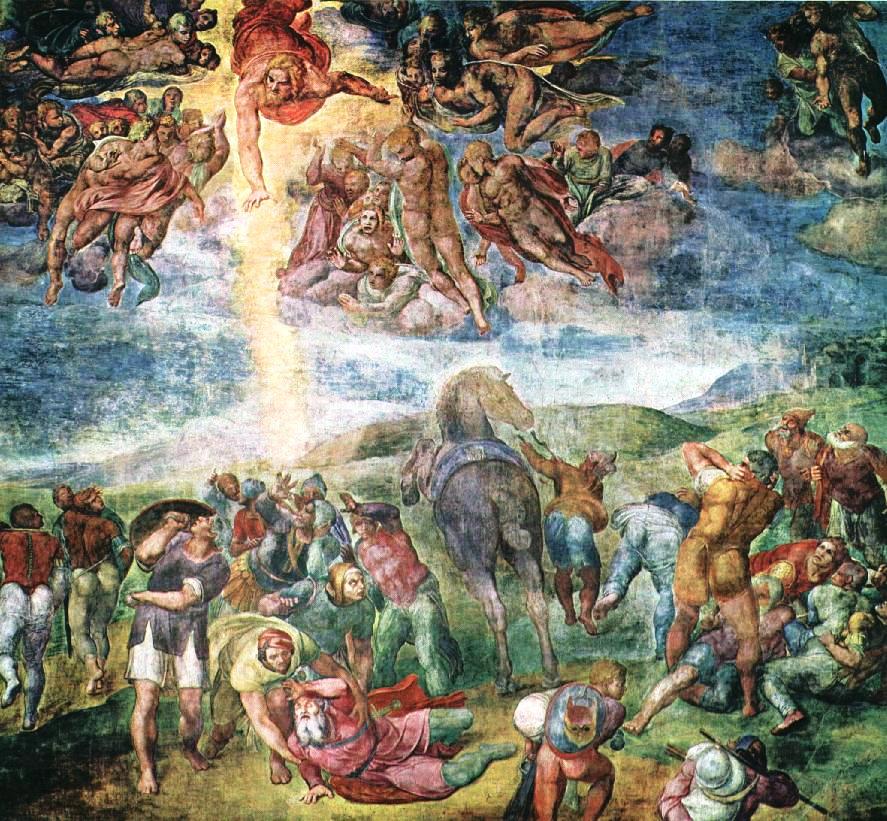
While being exposed to a higher power can be awe inspiring, it can also be intensely overwhelming for those experiencing it. These experiences reveal a form of knowledge that is instantly transformative. The historical example of Saul of Tarsus (later renamed St. Paul the Apostle) in the Christian New Testament is an example. Saul was a Pharisee heavily involved in the persecution of Christians. While on the road to Damascus Jesus appeared to him in a life-changing vision.
And as he journeyed, he came near Damascus: and suddenly there shined round about him a light from heaven:
And he fell to the earth, and heard a voice saying unto him, Saul, Saul, why persecutest thou me?
And he said, Who art thou, Lord? And the Lord said, I am Jesus whom thou persecutest: it is hard for thee to kick against the pricks.
And he trembling and astonished said, Lord, what wilt thou have me to do? And the Lord said unto him, Arise, and go into the city, and it shall be told thee what thou must do.
And the men which journeyed with him stood speechless, hearing a voice, but seeing no man.
And Saul arose from the earth; and when his eyes were opened, he saw no man: but they led him by the hand, and brought him into Damascus.
And he was three days without sight, and neither did eat nor drink (Acts 9:1-22).
The experience of divine revelation overwhelmed Saul, blinded him for three days, and prompted his immediate conversion to Christianity. As a result, he lived out his life spreading Christianity through the Roman Empire.
While specific religious experiences of transformation like Saul’s are often the source or goal of religious practice, established religions vary in how they relate to them. Are these types of experiences open to all members, or just those spiritual elites like prophets, shamans, saints, monks, or nuns who hold a certain status? Are practitioners encouraged to seek these experiences, or are the experiences suppressed? Is it a specific cultivated experience that is sought through disciplined practice, as in Zen Buddhism, or a more spontaneous experience of divine inspiration, like the experience of speaking in tongues in Evangelical congregations? Do they occur quite often, or are they more rare/singular? Each religion has their own answers to these questions.
Finally, the fourth common dimension of religion is the formation of specific forms of social organization or community. Durkheim (1915/1964) emphasized that religious beliefs and practices “unite in one single community called a Church, all those who adhere to them,” arguing that one of the key social functions of religion is to bring people together in a unified moral community. Dawson and Thiessen (2014) elaborate on this social dimension shared by all religions. First, the beliefs of a religion gain their credibility through being shared and agreed upon by a group. It is easier to believe if others around you (who you respect) also believe. Second, religion provides an authority that deals specifically with social or moral issues, such as determining the best way to live life. It provides a basis for ethics and proper behaviours, which establish the normative basis of the community. Even as many Canadians move away from traditional forms of religion, many still draw their values and ideals from some form of shared beliefs that are religious in origin (e.g., “Do unto others as you would have them do unto you”). Third, religion also shapes different aspects of social life, by acting as a form of social control, and supporting the formation of self-control that is vital to many aspects of a functional society. Fourth, although it may be on the decline in Canada, places of religious worship work as social hubs within communities, providing entertainment, socialization, and support.
By looking at religions in terms of these four dimensions — belief, ritual, experience, and community — sociologists can identify the important characteristics they share while taking into consideration and allowing for the great diversity of the world religions.
| World Religion | Origins | Beliefs | Rituals and Practices |
|---|---|---|---|
| Judaism Symbol: The star of David |
Judaism began in ancient Israel about 4,000 years ago. The prophet Abraham was the first to declare that there was to be only one true God. Moses, centuries later, then led the Jewish people away from slavery in Egypt, which was a defining moment for Judaism. Moses is credited with writing the Torah, the sacred Jewish texts, which consists of the five books of Moses. | Followers of Judaism are monotheistic, believing that there is only one true God. Israel is the sacred land of the Jewish people, and it is seen as gift to them — the children of Israel — from God. According to the Torah, Jewish believers must live a life of obedience to God because life itself is a gift granted by God to his disciples (Sanders, 2009).
Followers of Judaism live in accordance with the ten commandments revealed to Moses by God on Mount Sinai. These commandments outline the instructions for how to live life according to God. |
Judaism has many rituals and practices that followers of the faith carry out. Jewish people have strict dietary laws that originate in the Torah, called Kosher laws. The goal of these laws is not a concern for health, but for holiness. Examples of foods that are prohibited include, pig, hare, camel, and ostrich meat, and crustacean and molluscan seafood. Additionally, certain food groups are banned from being consumed when combined, for example, meat and dairy together (Tieman & Hassan, 2015). Other examples of Jewish rituals are the practices of circumcision and Bar and Bat Mitzvahs. These rites of passage for young boys (bar) and young girls (bat) mark the transition into manhood and womanhood. During these celebrations, the coming-of-age process is celebrated. Jewish followers also carry out multiple prayers each day, reaffirming and demonstrating their reciprocal love with God. |
| Christianity Symbol: The Cross |
Christianity began in approximately 35 CE — i.e., the date of the crucifixion — in the Middle East, in an area now known as Israel. Christianity began with recognition of the divinity of Jesus of Nazareth (Dunn, 2003). A poor Jewish man, Jesus was unsatisfied with Judaism and took it upon himself to seek a stronger connection to the word of God defined by the prophets. Thus, Christianity initially developed as a sect of Judaism. It developed into a distinct religion as Jesus developed a stronger following of those who believed that he was the son of God. The crucifixion of Jesus was the first of many tests of faith of Christians (Guy, 2004). A division emerged within Christianity between Eastern Orthodoxy and Roman Catholicism with the division of the Roman Empire into East and West. A second division occurred during the Protestant Reformation when Protestant sects emerged to challenge the authority of the Catholic church and Papacy to be intermediaries between God and Christian believers. |
At the core, to be Christian is to believe in the trinity of father, son, and holy spirit as one God: The God of love. Out of love for humanity, God allowed his only son to be sacrificed in the crucifixion to expiate their sins. Christians are admonished to love God, and to love their neighbours and enemies “as themselves.” They believe in God’s love for all things, have faith that God is always watching over them, and that Jesus, the son of God, will return when the world is ready. Jesus is the exemplar of the religion, demonstrating the way in which to be a proper Christian. In the Christian faith, the theodicy, or the way Christianity explains why God allows bad things to happen to good people, is shown through faith in Jesus. If believers follow in Jesus’ footsteps, they will have access to heaven. Unfortunate occurrences are acts of God that test the faith of his followers. Therefore, by keeping their faith in God’s love, Christians can carry on with their lives when confronted with tragedy, injustice, and suffering. | There are many rituals and practices that are central to Christianity, known as the sacraments. For example, the sacrament of baptism involves the literal washing of the person with water to represent the cleansing of their sins. Today, the ritual of baptism has become less common, however, historically the process of baptism was considered an integral rite to christen the individual and to wipe away their ancestral or original sin (Hanegraaff, 2009). Other sacraments include the Eucharist (or communion), confirmation, penance, anointing the sick, marriage, and Holy Orders (or ordination). However, not all sects of Christianity follow these. One of the core qualities and practices of Christianity is caring for the poor and disadvantaged. Jesus, a poor man himself, fed and nurtured the poor, demonstrating care for all, and is thus seen to be the exemplar of morality (Dunn, 2003). Christian churches are often institutions that demonstrate how to follow Jesus, running charities and food banks, and housing the homeless and the sick. |
| Islam Symbol: Crescent and the Star |
Originating in Saudi Arabia, Islam is a monotheistic religion that developed in approximately 600 CE. During this time, the society of Mecca was in turmoil. Muhammad, God’s messenger, received the verses of the Quran directly from the Angel Gabriel during a period of isolated prayer on Mt. Hira. He developed a following of people who eventually united Arabia into a single state and faith through military struggle against polytheistic pagans. Followers of the Islamic faith are referred to as Muslims. Today, a division exists with Islam originating from disagreement about Muhammad’s legitimate successor. These two groups are known as Sunni’s and Shia’s, the former making up the majority of Muslims. |
Central to Islam is the belief that the God, Allah, is the only true God and that Muhammad is God’s Messenger, otherwise known as the Prophet. God also demands that Muslims be fearful and subservient to him as He is the master, and the maker of law (Ushama, 2014). In Islamic faith, the Quran is the sacred text that Muslims believe is the direct word of God, dictated by the Angel Gabriel to Muhammad (Ushama, 2014). |
Islam outlines five pillars that must be upheld by Islamic followers if they are to be true Muslims.
|
| Hinduism Symbol: Om or Aum |
Hinduism originated in India and Nepal; however, the exact origin of this widespread religion is highly contested. There is no known founder, differing strongly from the other religions discussed here, which have strong origin stories of the individuals that first posited the specific way of religious life (Flood, 1996). | The characteristic beliefs of Hinduism are a belief in reincarnation, and a belief that all actions have direct effects, referred to as Karma (Flood, 1996). In contrast with other world religions, Hinduism is not as strongly defined by what followers believe in but instead by what they do. The Dharma is what outlines a Hindu’s duty in life, identifying individuals with a place within the dharmic social stratification system, or the caste system. This classification greatly dictates what a Hindu can and cannot do. Hindu followers believe in one God that is represented by a multitude of sacred forms known as deities (Flood, 1996). In Hindu religion, in death, only the body dies while the soul lives on. Individuals are reincarnated, surviving death to be reborn in a new form. This new form is believed to be dependent on the way in which the individual lived their life, with the proper way identified as acting in accordance with the duties of their caste position (Flood, 1996). | In the religion of Hinduism, practice is more important than belief. One ritualistic practice that is carried out by Hindu followers is the act of making offerings of incense to the deities. This act of offering is seen as a “mediation” to open to the lines of communication between the sacred and the profane, or the deity and the individual. This correspondence is of great significance to Hindu followers (Flood, 1996). Another widespread ritual practice is yoga, which is a practice of holding postures while focusing on one’s breath. Yoga is used to silence the mind, allowing it to reflect the divine world. This practice brings the believer closer to unification with the divine. |
| Buddhism Symbol: The Dharma Wheel (the eight spokes of this wheel represent the eightfold path). |
Buddhism refers to the teachings of Siddhartha Gautama (Buddha). It originated in India in approximately 600 BCE. Buddha, originally a follower of the Hindu faith, experienced enlightenment, or Bodhi, while sitting under a tree. It was in this moment that Buddha was awakened to the truth of the world, known as the Dharma. Buddha, an ordinary man, taught his followers how to follow the path to Enlightenment. Thus, Buddhism does not believe in a divine realm or God as a supernatural being, but instead follows the wisdom of the founder (Rinpoche, 2001). | Buddhists are guided through life by the Dharma, or four noble truths.
|
The noble eight-fold path includes eight prescriptions: right view, right intention, right speech, right action, right livelihood, right effort, right mindfulness, and right concentration. These outline the “middle path” between the extremes of sensualism and asceticism, which leads to true knowledge, peace, and enlightenment (Tsersing, 2005). A key ritual practice of Buddhism is meditation. This practice is used by followers to learn detachment from desire and gain insight into the inner workings of their mind, coming to greater understandings of the truth of the world. In the Buddha’s example, meditation on breath or on chanted mantras, which are often key passages of the Buddha’s sutras (teachings), is a key practice to reach the place of Enlightenment or awakening. |
Making Connection: Social Policy and Debate
Residential Schools and the Church
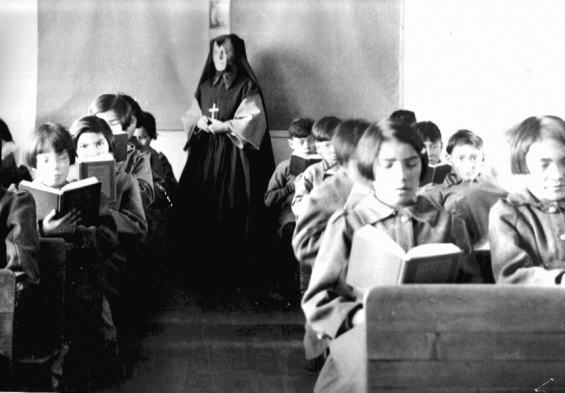
Residential schools were a key institution responsible for the undermining of Aboriginal culture in Canada. Residential schools were run by the Canadian government alongside the Anglican, Presbyterian, Roman Catholic, and United Churches (Blackburn, 2012). These schools were created with the purpose of assimilating Aboriginal children into North American culture (Woods, 2013).
In 1920, the government legally mandated that all Aboriginal children between the ages of seven and fifteen attend these schools (Blackburn, 2012). They took the children away from their families and communities to remove them from all influence of their Aboriginal identities that could inhibit their assimilation. Many families did not want their children taken away and would hide them, until it became illegal (Neeganagwedgin, 2014). Under the Indian Act, they were also not allowed lawyers to fight government action, which added greatly to the systemic marginalization of these people. The churches were responsible for daily religious teachings and daily activities, and the government oversaw the curriculum, funding, and monitoring of the schools (Blackburn, 2012).
There were as many as 80 residential schools in Canada by 1931 (Woods, 2013). It was known early on in this system that there were flaws, but they persisted until the last residential school was abolished in 1996. As we now know, the experience of residential schools for Aboriginal children was traumatic and dreadful. Within the walls of these schools, children were exposed to sexual and physical abuse, malnourishment, and disease. They were not provided with adequate clothing or medical care, and the buildings themselves were unsanitary and poorly built.
The Roman Catholic Church created the most residential schools, with the Anglican Church second (Woods, 2013). There has been much debate surrounding the Church’s involvement in these atrocious organizations. Former Primate and Archbishop Michael Peers apologized in 1993 for the Anglican Church’s part in the residential schools. Canada’s first Aboriginal Anglican Bishop Gordon Beardy forgave the Anglican Church in 2001.
By 2001, there were more than 8,500 lawsuits against the Churches and Canadian government for their role in the residential schools (Woods, 2013). Because of the Indian Residential Schools Settlement Agreement, former students of the residential schools are now eligible for $10,000, on top of $3,000 for each year they attended the schools. A lawsuit filed by former students of the Alberni Indian Residential School was one of the first to get to the Supreme Court of Canada, and the first to consider both the government and church equally responsible.
On behalf of the churches involved in the residential schools, apologies are still being made, but the effects it has had on the Indigenous peoples and their culture are perpetuating today. The Christian churches and mission groups have done good things for societies, but their role in these residential schools was immoral and unjust to the Aboriginal people.
Types of Religious Organization
In every society, there are different organizational forms that develop for the practice of religion. Sociologists are interested in understanding how these different types of organization affect spiritual beliefs and practices. They can be categorized according to their size and influence into churches (ecclesia or denomination), sects, and cults. This allows sociologists to examine the different types of relationships religious organization has with the dominant religions in their societies and with society itself.
A church is a large, bureaucratically organized religious organization that is closely integrated into the larger society. Two types of church organizations exist. The first is the ecclesia, a church that has formal ties with the state. Like the Anglican Church of England, an ecclesia has most or all of a state’s citizens as its members. As such, the ecclesia forms the national or state religion. People ordinarily do not join an ecclesia; instead, they automatically become members when they are born. Several ecclesiae exist in the world today, including Salifi Islam in Saudi Arabia, the Catholic Church in Spain, the Lutheran Church in Sweden, and, as noted above, the Anglican Church in England.
In an ecclesiastic society, there may be little separation of church and state, because the ecclesia and the state are so intertwined. Many modern states deduct tithes automatically from citizen’s salaries on behalf of the state church. In some ecclesiastic societies, such as those in the Middle East, religious leaders rule the state as theocracies — systems of government in which ecclesiastical authorities rule on behalf of a divine authority — while in others, such as Sweden and England, they have little or no direct influence. In general, the close ties that ecclesiae have to the state help ensure they will support state policies and practices. For this reason, ecclesiae often help the state solidify its control over the populace.
The second type of church organization is the denomination, a religious organization that is closely integrated into the larger society, but is not a formal part of the state. In modern religiously pluralistic nations, several denominations coexist. In Canada, for example, the United Church, Catholic Church, Anglican Church, Presbyterian Church, Christian and Missionary Alliance, and the Seventh-day Adventists are all Christian denominations. None of these denominations claim to be Canada’s national or official church, but exist instead under the formal and informal historical conditions of separation between church and state.
In Canada, denominationalism developed formally as a result of the Treaty of Paris in 1763, which granted Roman Catholics the freedom to practice their religion. Denominationalism also developed informally from the immigration of people with different faiths during the expansion of settlement of Canada in the 19th and early 20th centuries. Under the model of denominationalism, many different religious organizations compete for people’s allegiances, creating a kind of marketplace for religion. In the United States, this is a formal outcome of the Constitutional 1st Amendment protections: “Congress shall make no law respecting an establishment of religion, or prohibiting the free exercise thereof.” “Freedom of religion” was not constitutionally protected in Canada until the introduction of the Charter of Rights and Freedoms in 1982.
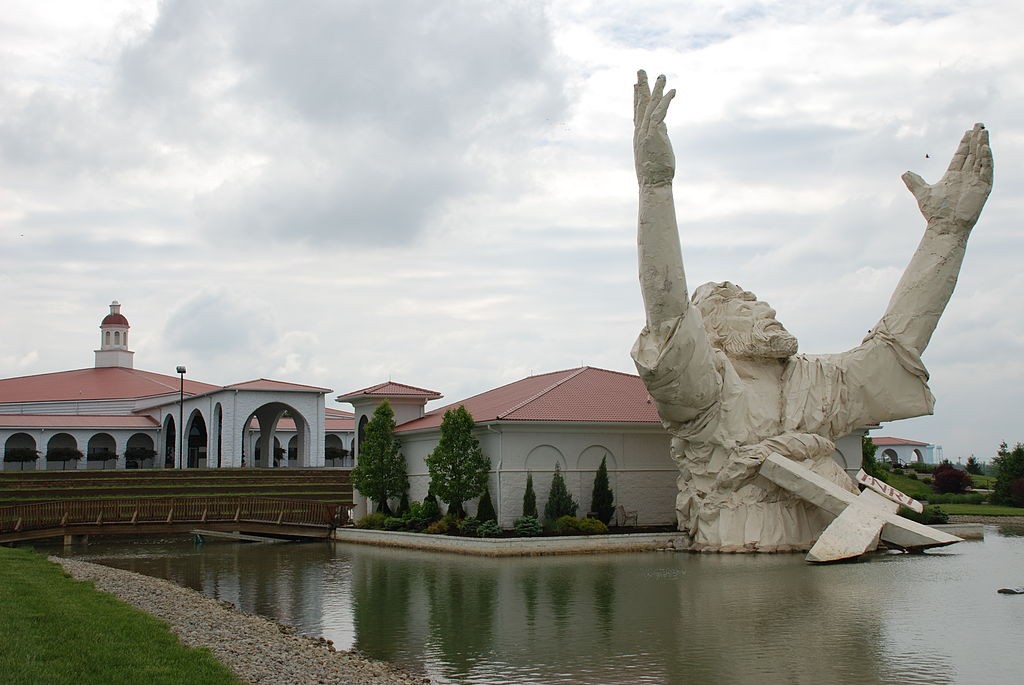
A relatively recent development in religious denominationalism is the rise of the so-called megachurch in the United States, a church at which more than 2,000 people worship every weekend on average (Priest, Wilson, & Johnson, 2010; Warf & Winsberg, 2010). These are both denominational and non-denominational (i.e., not officially aligned with any specific established religious denomination). About one-third are nondenominational, and one-fifth are Southern Baptist, with the remainder primarily of other Protestant denominations. Several dozen have at least 10,000 worshippers and the largest U.S. mega church, in Houston, has more than 35,000 worshippers, nicknamed a “gigachurch.” There are more than 1,300 mega churches in the United States — a steep increase from the 50 that existed in 1970 — and their total membership exceeds 4 million.
Compared to traditional, smaller churches, mega churches are more concerned with meeting their members’ non-spiritual, practical needs, in addition to helping them achieve religious fulfillment. They provide a “one-stop shopping” model of religion. Some even conduct market surveys to determine these needs and how best to address them. As might be expected, their buildings are huge by any standard, and often feature bookstores, food courts, and sports and recreation facilities. They also provide day care, psychological counseling, and youth outreach programs. Their services often feature electronic music and light shows. Despite their popularity, they have been criticized for being so big that members are unable to develop close bonds with each other and with members of the clergy, which is characteristic of smaller houses of worship. On the other hand, supporters say mega churches bring many people into religious worship who would otherwise not be involved.
A sect is a small religious body that forms after a group breaks away from a larger religious group, like a church or denomination. Dissidents believe that the parent organization does not practice or believe in the true religion as it was originally conceived (Stark & Bainbridge, 1985). Sects are relatively small religious organizations that are not closely integrated into the larger society. They often conflict with at least some of its norms and values. The Hutterites are perhaps the most well-known example of a contemporary sect in Canada; an Anabaptist group — literally “one who baptizes again” — that broke away from mainstream Christianity in the 16th century. Their migration from Tyrol, Austria, due to persecution eventually lead to their immigration to the Dakotas in the 19th century and then to the Canadian prairies, as conscientious objectors following WWI.

Typically, a sect breaks away from a larger denomination in an effort to restore what members of the sect regard as the original views of the religion. Because sects are relatively small, they usually lack the bureaucracy of denominations and ecclesiae, and often also lack clergy who have received official training. Their worship services can be intensely emotional experiences, often more so than those typical of many denominations, where worship tends to be more formal and restrained. Members of many sects typically proselytize and try to recruit new members into the sect. If a sect successfully attracts many new members, it gradually grows, becomes more bureaucratic, and ironically evolves into a denomination. Many of today’s Protestant denominations began as sects, as did the Hutterites, Mennonites, Quakers, Doukhobors, Mormons, and other groups.
A cult or New Religious Movement is a small religious organization that is at great odds with the norms and values of the larger society. Cults are similar to sects but differ in at least three respects. First, they generally have not broken away from a larger denomination and instead originate outside the mainstream religious tradition. Second, they are often secretive and do not proselytize as much. Third, they are at least somewhat more likely than sects to rely on charismatic leadership based on the extraordinary personal qualities of the cult’s leader.
Although the term “cult” raises negative images of crazy, violent, small groups of people, it is important to keep in mind that major world religions, including Christianity, Islam, and Judaism, and denominations such as the Mormons all began as cults. Cults, more than other religious organizations, have been subject to contemporary moral panics about brainwashing, sexual deviance, and strange esoteric beliefs. However, research challenges several popular beliefs about cults, including the ideas that they brainwash people into joining them and that their members are mentally ill. In a study of the Unification Church (Moonies), Eileen Barker (1984) found no more signs of mental illness among people who joined the Moonies than in those who did not. She also found no evidence that people who joined the Moonies had been brainwashed into doing so.
Another source of moral panic about cults is that they are violent. In fact, most are not violent. Nevertheless, some cults have committed violence in the recent past. In 1995 the Aim Shinrikyo (Supreme Truth) cult in Japan killed 10 people and injured thousands more when it released bombs of deadly nerve gas in several Tokyo subway lines (Strasser & Post, 1995). Two years earlier, the Branch Davidian cult engaged in an armed standoff with federal agents in Waco, Texas. When the agents attacked its compound, a fire broke out and killed 80 members of the cult, including 19 children; the origin of the fire is still unknown (Tabor & Gallagher, 1995).
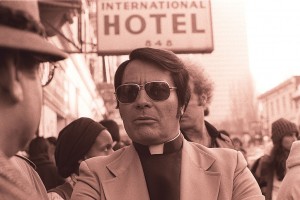
A few cults have also committed mass suicide. More than three dozen members of the Heaven’s Gate cult killed themselves in California, in March 1997, in an effort to communicate with aliens from outer space (Hoffman & Burke, 1997). Some two decades earlier, in 1978, more than 900 members of the People’s Temple cult killed themselves in Guyana under orders from the cult’s leader, the Reverend Jim Jones (Stoen, 1997). Similarly, in Canada, on the morning of October 4th, 1994, a blaze engulfed a complex of luxury condominiums in the resort town of Morin-Heights, Quebec. Firefighters found the bodies of a Swiss couple, Gerry and Collette Genoud, in its ruins. At first it was thought that the fire was accidental, but then news arrived from Switzerland of another odd set of fires at homes owed by the same men who owned the Quebec condominiums. All the fires had been set with improvised incendiary devices, which made the police realize they were dealing with a rare incidence of mass murder suicide involving members of an esoteric religious group known as the Solar Temple. From the recorded and written messages left behind by the group, it is clear that the leaders felt it was time to affect what they called a transit to another reality associated with Sirius.
It is important to note that cults or new religious movements are very diverse. They offer spiritual options for people seeking purpose in the modern context of state secularism and religious pluralism. Being intense about one’s religious views often breaks the social norms of largely secular societies, leading to misunderstandings and suspicions. Members of new religions run the risk of being stigmatized and even prosecuted (Dawson, 2007). Modern societies highly value freedom and individual choice, but not when exercised in a manner that defies expectations of what is normal.
Making Connections: Case Study
Brother XII and the Aquarian Foundation

Born as Edward Arthur Wilson, the man known as Brother XII travelled the world as a sailor studying various religions. Even at a young age he claimed to be in touch with supernatural beings (Gorman, 2012). In 1927, having taken the name of Brother XII, Wilson established the Aquarian Foundation at Cedar-by-the-Sea, just south of Nanaimo on Vancouver Island, which expanded to include colonies on nearby De Courcy and Valdez Islands. At its height it had over 2000 followers around the world, many of whom sent over large sums of money.
The Aquarian Foundation was based on the teachings on the Theosophical Society, which was an organization formed in New York City in 1875. Theosophy had much in common with the beliefs of Buddhism and Hinduism, such as the belief in reincarnation. It was radically different than the dominant Christian belief of the time. Instead of a separation of the spiritual world and the natural world, spirit and nature were intertwined in people’s daily lives as one universal life force. Theosophy also promoted the idea that there was a spiritual world beyond death inhabited by evolved spiritual beings, whose wisdom could be accessed through the occult reading of esoteric signs and the intervention of spiritual mediums (Scott, 1997).
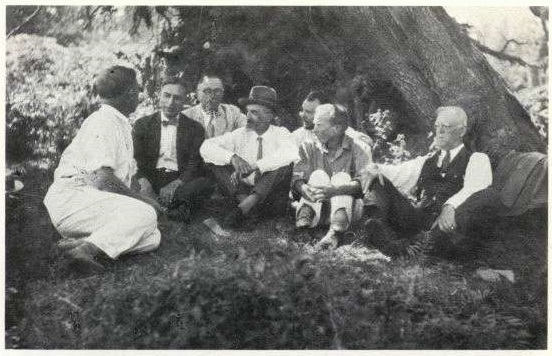
At the time Brother XII ‘s ambitions seemed reasonable enough and many felt the foundation itself represented the promise of great spiritual renewal for an increasingly materialistic society. Brother XII had his followers build homes and cabins at the foundation’s headquarters at Cedar-by-the-Sea and on De Courcy Island. These isolated areas provided a place to get away from the social pressures of the outside world. However, an insurrection took place when Brother XII announced to his followers that he was the reincarnation of the Egyptian God Osiris. Between 1928 and 1933, a series of trials involving Brother XII occurred, which included allegations of misusing foundation funds and having extramarital affairs. News reports claimed that he used black magic to cause witnesses and several members of the audience to faint (Rutten, 2009).
In 1929, as rumours about Wilson’s behaviour spread, the B.C. provincial cabinet dissolved the foundation. Those who remained were subjected to Wilson’s paranoia and became increasingly isolated from the outside world. Wilson himself became increasingly authoritarian and used social pressure to convince members into performing gruelling physical labour that was virtually on the same level as slavery. He did this by telling them these activities were tests of fitness to advance their spirituality. In 1931, the group was finally dissolved, and Wilson disappeared from the Nanaimo area along with hundreds of thousands of dollars of Foundation money and Mabel Skottowe (one of the women with whom he was accused of having an extramarital affair). They reportedly left by tugboat and eventually made their way to Switzerland. Most reports say he died in Switzerland in 1934, though some say he was seen in San Francisco with his lawyer after his alleged death.
The story of Brother XII illustrates many themes from the sociology of New Religious Movements and cults. According to Cowan (2015), because most people have little direct knowledge of cults and mainly get their information through sensationalist media reports, cults are easily presented as targets of moral panic for being immoral, extreme, or dangerous. The three main accusations against cults are that they engage in brainwashing, acts of sexual deviance, and social isolationism. Each of these accusations applied to the media reports on the Aquarian Foundation although their dominant theme centered on the claim that Brother XII was a fraud.
Image Descriptions
Figure 15.6 Long Description: A painting of God in the sky, surrounded by his angels, with his hand pointed down and beam of light shining from it. Below, people look panicked and stare up at the sky. Many have fallen and one man has fainted. [Return to Figure 15.6]
Media Attributions
- Figure 15.4 Ayahuasca (called “Santo Daime” in Santo Daime religion) waiting for beginning of the ceremonial work by Aiatee, via Wikimedia Commons, is used under CC BY-SA 3.0 licence
- Figure 15.5 May the Almighty grants our prayers by Shaeekh Shuvro, via Flickr, is used under CC BY SA 2.0 licence.
- Figure 15.6 Conversion of Saul by Michelangelo, via Wikimedia Commons, is in the public domain.
- Figure 15.7 Students from Fort Albany Residential School, Ontario, reading in class overseen by a nun circa 1945 from Edmund Metatawabin collection at the University of Algoma, via Wikimedia Commons, is in the public domain.
- Figure 15.8 King of Kings by Joe Shlabotnik, via Wikimedia Commons, is used under a CC BY 2.0 licence.
- Figure 15.9 Hutterite girl holding her baby sister by Galt Museum & Archives on The Commons (Flickr), via Wikimedia Commons. No known copyright restrictions exist.
- Figure 15.10 Reverend Jim Jones at a protest in front of the International Hotel, 848 Kearny Street in San Francisco in 1977 by Nancy Wong, via Wikimedia Commons, is used under a CC BY-SA 3.0 licence.
- Figure 15.11 Brother Twelve, Cover illustration for The Wide World magazine, December, 1942, from brotherxii.com, is in the public domain.
- Figure 15.12 Brother Twelve by unknown photographer, from McKelvie, 1966, is in the public domain.

